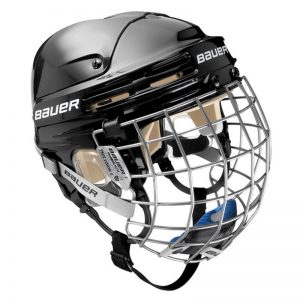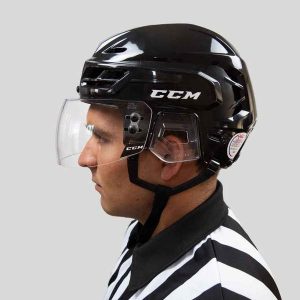
Now that you learned how to protect your head, let’s talk about hockey helmet face shields.
We all know the classic hockey look: a grin missing a tooth or two. It’s a look we all admire, but unless you have a million-dollar contract or an on-call dentist, you are better off keeping your teeth right where they are.
There are four main options when it comes to hockey helmet face shields: cages, visors, fishbowls, and hybrids. Choosing the right one is a mix of personal preference and what your league allows.
Let’s check out these pros, cons, and a few tips on choosing the best protection for your face.

Hockey Helmet Cages
Hockey cage face masks are crafted from materials like steel or titanium wire, which are not just tough but also pretty lightweight. They’re built to take a hit from flying pucks, the occasional stick, or even a direct collision. They come in a bunch of colors like black, silver, white, and even gunmetal/gray, so you can pick one that goes well with the rest of your gear.
I’ve got to say, cages are a solid choice. They’re great at protecting your face and they won’t fog up on you when the game heats up. Plus, they’re usually the more budget-friendly option when it comes to face protection. A lot of helmets are sold as a helmet/cage combo which makes things easier and can save you a few bucks, too.
But let me stress this—being able to see is key. If you pop on a cage and find your view is blocked, that’s not the one for you. Make sure you’ve got the best line of sight between the bars as possible.
Pros:
- Offers the highest level of facial protection against pucks, sticks, and physical contact.
- No fogging or scratchmarks.
- Durable and long lasting.
Cons:
- Obstructs vision due to the bars.
Hockey Visors/Half Shields

Following a history of gruesome eye and facial injuries, the NHL decided to mandate visors for all incoming players in 2013. Even though visors provide added protection for the pros, we still see pucks and sticks getting under them. This is why they are not the safest option available to you.
If you’re really thinking of forgoing the protection of full hockey helmet face shields, allow me to dissuade you. Do you recall the injury suffered by Bryan Berard? His eyeball ruptured at the end of Marian Hossa’s stick, an accident resulting in permanent eye damage and life-changing trauma. And then there was Chris Pronger, whose brutal eye injury also occurred by way of errant stick. Never a fan of the half shield, the bare-faced bruiser ultimately returned to action donning this piece of protection at the behest the team’s ophthalmologist. In recent years, two-time Stanley Cup champion, Carl Hagelin, was forced into retirement at age 35 due to a severe eye injury sustained in a Capitals team practice session.
As you can see, these types of injuries can be absolutely devastating.
If you’re still dead set on using a visor, make sure it lines up with the top of your helmet; a little overlap is fine. The middle part should give you about an inch of space from the helmet. The bottom should be right in line or just a tad below your nose. And don’t forget your mouthguard.
Pros:
- Provides excellent visibility with minimal obstruction.
- Protects the eyes and upper face while allowing for better airflow.
Cons:
- Lower face remains unprotected.
- Can fog up, although less so than full shields.
- Pucks and sticks can still sneak under and cause eye injuries.
Tinted/Mirrored/Colored Visors

Alright, for those of you wanting to channel your inner vintage Ovechkin or just add a bit of pizzazz to your look, let’s talk about tinted, mirrored, or colored visors. Besides the style points, these visors can actually be pretty handy in bright arenas or if you’re playing outdoors—they help cut down on glare, which is a plus.
Take Ovechkin, for example. Back in a 2005 interview with The Hockey News, he flat out said, “Tinted visor is just my style. I only wear it for that reason.” But not everyone was a fan. Marty Brodeur raised a stink about it, and before you knew it, the league’s GMs had voted 29-1 to ban the visor. Goes to show, style can definitely make waves.
But before you rush out to get one, do a quick check with your local league’s rules on hockey helmet face shields. While most leagues are cool as long as the visors meet safety standards and don’t endanger anyone, it’s better to be safe than sorry. And really, as long as you’re not compromising safety, why not add a little flair to your game?
Pros:
- Reduce glare and can enhance focus by dimming harsh lighting.
- Offer a unique style and can provide a psychological edge or team identity.
- Mirrored and tinted options can obscure opponents’ view of the eyes, hiding intentions.
Cons:
- Some leagues have restrictions on tinted or mirrored visors.
- Can affect visibility in lower light conditions.
The Fishbowl

The fishbowl hockey face shield—or as some like to call it, the “hockey bubble mask”—is like the metal cage’s cooler cousin. It offers the same level of face protection but ditches the bars, giving you a clear, unobstructed view of the ice. It’s something that you just can’t get with traditional metal cages. There’s no squinting through bars to see the puck; it’s all there in HD clarity. However, your view can potentially become obstructed due to fogging and scratching over time, which brings us to the materials.
These masks are usually made from high-quality polycarbonate. It’s tough, impact-resistant, and gives you a solid layer of protection. It’s basically the Bob Probert of plastics and it’s a great option to shield your face while also upgrading your in-game vision.
Here’s a couple of pro tips to keep your bubble in prime condition: Anti-fog spray is your new best friend. Give it a good coat before hitting the ice to keep things clear. And when it comes to scratches, treat your fishbowl like it’s made of gold. Clean it gently with a soft cloth and some mild soap. No rough handling or you’ll end up with a view like you’re looking through a sandstorm.
And yeah, you might catch a bit of friendly flak from your teammates for rocking the fishbowl. It comes with the territory. But if you’ve ever dreamt of pulling off the flying V with your fellow Mighty Ducks, this is your chance. Embrace it, own it, and let ’em know who’s boss on the ice.
Pros:
- Offers full facial protection without the visual obstruction of cage bars.
- Provides clear, unobstructed visibility across the entire face.
- Prevents direct contact with pucks, sticks, and physical play.
Cons:
- Prone to fogging, which can hinder visibility.
- Susceptible to scratches, which can also affect visibility over time.
- Some players may find it less breathable compared to other options.
Half Cage/Half Visor Hybrid Face Masks

Let’s dive into the world of hybrids now. The hybrid shield is all about giving you the best of both worlds. Picture this: the clear, unobstructed view of a visor up top, with the solid, reassuring protection of a cage for your chin and mouth down below.
Hybrids amp up your peripheral vision. No more getting blindsided because your side view is blocked by bars. And then there’s the breathing part. If you’ve ever felt like you were trying to suck air through a straw with a fishbowl on, the hybrid shield is going to feel like a breath of fresh air—literally. It’s all about keeping that airflow going without sacrificing protection.
For folks who are always strategizing on the ice, this setup lets you keep your head on a swivel and spot those sneaky passes without losing an inch of coverage on the lower half of your face.
Pros:
- Combine the clarity of visors with the protection of cages at the lower face.
- Improved peripheral vision compared to traditional cages.
- Some players find them more comfortable and easier to breathe in than full cages or fishbowls.
Cons:
- Visor part might be susceptible to scratches.
- Could be slightly less breathable than a full cage.
No Face Protection
Some players opt to wear no face protection at all. This is stupid, don’t do it.
We’ve all seen those old-school hockey photos where nobody’s wearing a helmet, let alone something to protect their face, and yeah, it’s got a certain rugged charm to it. But let’s not romanticize it too much. The game’s fast, the puck’s hard, and those sticks aren’t exactly soft.
Whether it’s a cage, a visor, a hybrid, or even a fishbowl, wearing something is infinitely better than nothing. Play smart, stay safe, and keep enjoying the game. Because at the end of the day, hockey’s about having a good time, not about taking unnecessary risks.
Leave a Reply